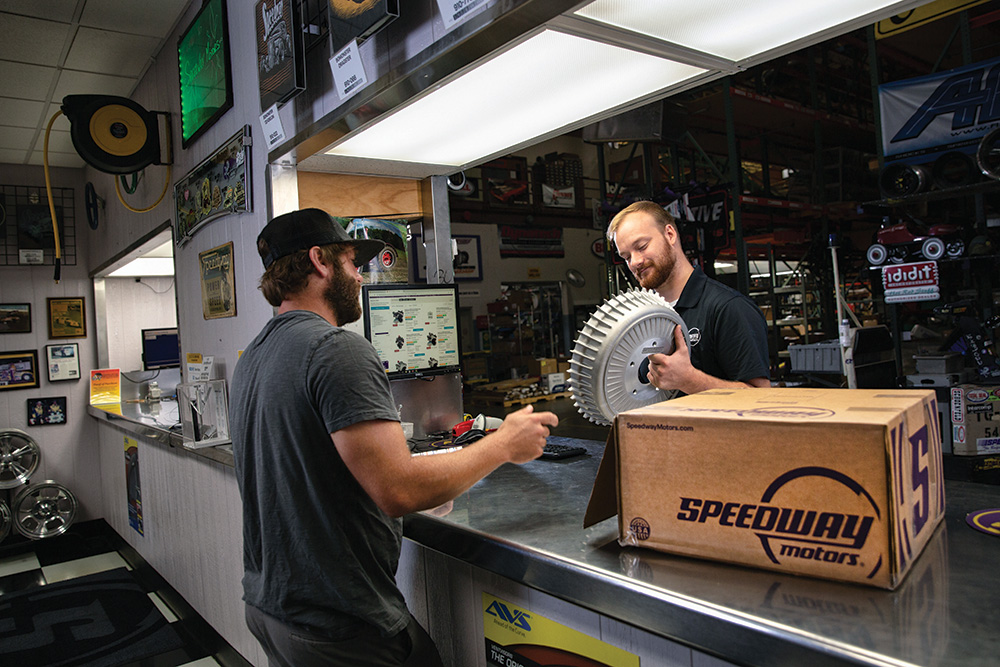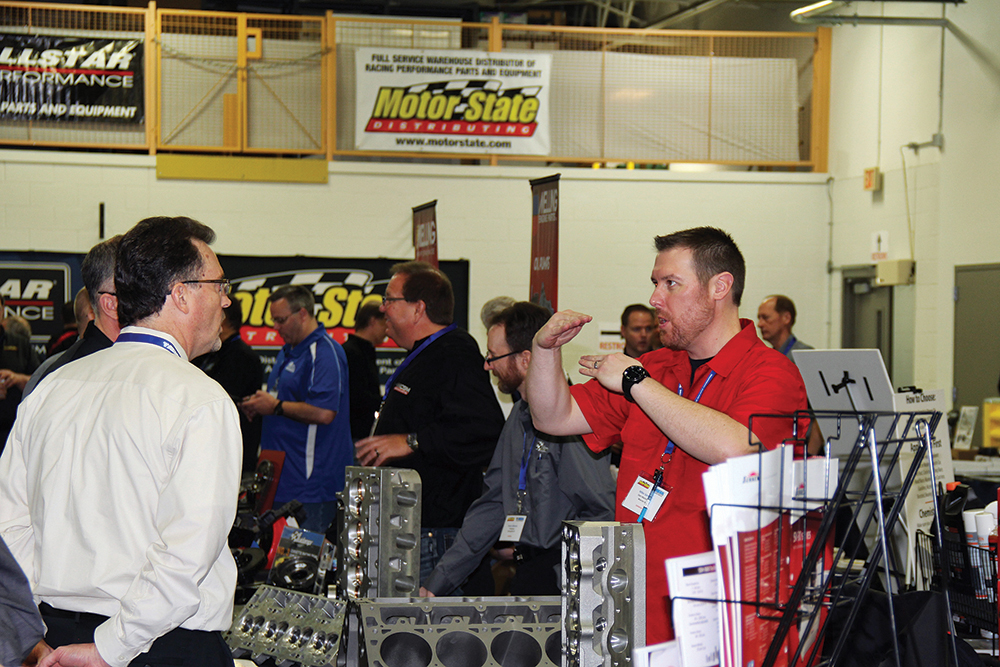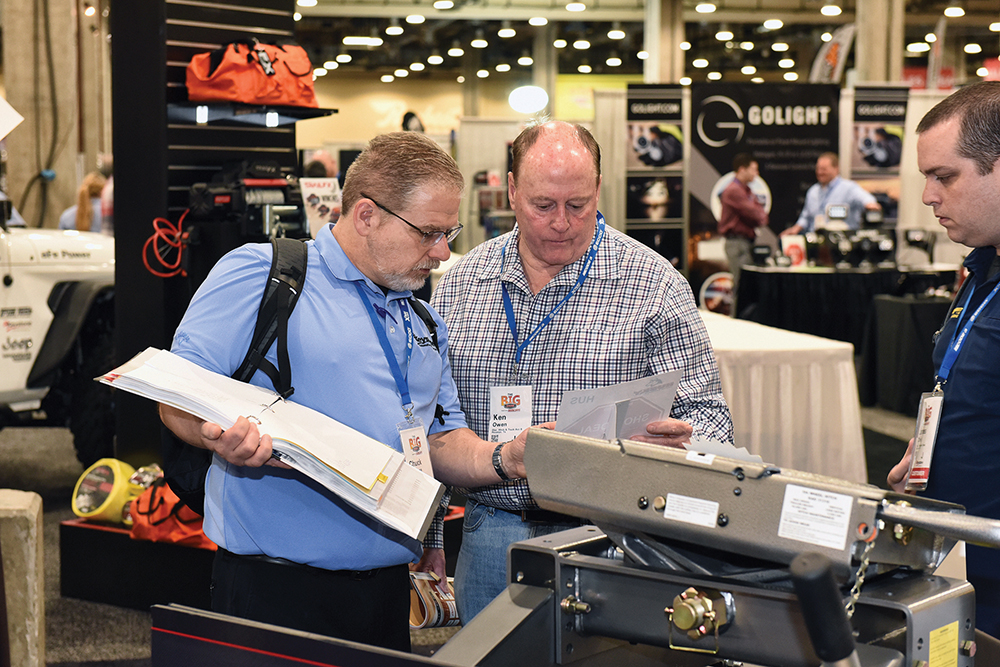PARTNERS IN PARTS
For racing and performance WDs, relationship building is just as important as carrying the proper inventory in today’s ultra-competitive marketplace.
Being a WD isn’t easy.
Many of today’s top-tier distributors offer a number of the same products as one another, with the Internet allowing transparent pricing that can be compared instantly between competitors. The result is that customers often shop prices aggressively, jumping from one WD to another to chase the latest specials or deals.
At the same time, WDs also battle indirectly with some of the toughest competitors in the industry—large, online equipment retailers. With a limited number of customers for WDs to serve, online retailers create additional pressure on the independent-dealer business model. Ultimately, intense competition between WDs has driven many rounds of consolidation over the years, the most obvious being Turn 14 Distribution’s recent acquisition of Motovicity.
So how do WDs survive in this cutthroat environment? The smart ones do it by building relationships with their customers, focusing the bulk of their company’s resources on becoming an ally for the jobbers that order from them. If done right, this fosters strong repeat business and referrals, while at the same time allowing for a smaller marketing budget without the need to endlessly chase potential new customers.
MASTERING THE FUNDAMENTALS
Regardless of how sophisticated a particular WD is about relationship building, all of the ones we spoke with for this report agree that fostering customer loyalty has to start with the fundamentals—having the right products, keeping them in stock, providing fast shipment, and offering competitive prices. Along with this is the need for prompt, knowledgeable customer service.
“Probably the biggest deal is just establishing the trust and having a fair price,” said Greg Nicol of Speedway Motors, Lincoln, Nebraska. “There’s always someone out there that’s going to sell it cheaper. But if you can establish that you’ve already got what they need, and you’ve got the knowledgeable people to sell it to the customer, and that you can help them when they want to talk about what they need, that goes a long way.”
These essential elements are the first battleground for building strong customer relationships, and they’re the foundation that everything else in the loyalty game is built on. Without these pieces in place, all additional attempts at fostering relationships are almost certainly doomed.
With so much competition among WDs, there’s pressure to get every aspect of sales and fulfillment mechanisms right. It doesn’t take much in this business to break the customer’s trust. And because there are many alternatives generally available, the damage can be expensive and long lasting. Therefore, strong WDs tackle these fundamentals with a holistic approach, in which every aspect of customer interaction is polished, refined, and tuned.
“Relationship building is an integral part of what we do,” said Daryl Sampson of Turn 14 Distribution, Horsham, Pennsylvania. “We do so daily with our sales staff, our customer support team, and our accounts receiving team who work with customers on their billing and credit needs.”
Some WDs aim to further sharpen these aspects of the business by focusing on a particular range of products, and then shaping that into a competitive advantage built around specialist salespeople. “Our business has really morphed over the years,” said Tom Ressler of Nickels Performance, Piney Flats, Tennessee. “If you look at our business today versus even, say, a decade ago, because of online retailers, now our biggest segment of customers is engine builders. So all our phone salespeople are also tech people—engine builders or racers at some point back. That’s how we’re able to win out over warehouses that are all larger than us. They lack our technical capabilities.”
WORKING THE WEB
Beyond the essential foundation elements, strong customer relationships demand good communication. By getting in touch with customers frequently, efficiently, and in a compelling manner, companies can establish a running dialogue on everything from prices and specials to tips and guidance, thereby enhancing the relationship and what customers can gain from it.
Naturally, the tool that’s first enlisted for these conversations is the Internet. With frequent social media posts and email blasts, WDs can avoid the “out-of-sight-out-of-mind” effect that can weaken ongoing relationships in all businesses.
“Through our Facebook, Instagram, and Twitter feeds, and our free email blast, we keep our customers up to date on the newest events, sales, and product releases,” said Jon Lynch of Behrent’s Performance Warehouse, Florida, New York. “Providing our customers with a 24/7 website also helps them keep in touch and look for what they need, even after business hours.”
Many WDs take a somewhat informal approach to social media, posting videos, announcements, and product promotions as they come along. Some, however, pursue a more comprehensive strategy. “Most people who work in shops don’t necessarily have that as a badge written on all of their social media profiles saying that’s what they do for a living,” said Patrick Wagenbrenner of Keystone Automotive Operations, Eastvale, California. “So, we’re casting a wide net and engaging with the audience. Our Instagram focus is automotive performance. We’re building community around that and driving traffic to their local shop whoever that may be. Then that’s creating awareness for the shop and supporting the automotive community.
“We also like to think of ourselves as providing a lot of the same tools as a marketing agency would for our jobbers,” he continued. “Having an online, digital, and email presence is becoming increasingly important. But shops are busy. We provide the tools for our jobbers and act as their marketing agency. For instance, we have a broad selection of what we call Social Share. Our marketing team builds post-ready content—image, copy, everything—for jobbers, based on products. All the jobber has to do is one-click download, one-click post, and they have content that they’re able to use for their social platforms.”

TAKING IT LIVE
Despite the proliferation of sophisticated digital tools, most WDs still put a great deal of value on traditional face-to-face interaction. Most are consistent exhibitors at PRI, SEMA, and other trade shows throughout the year, seeing this as a crucial means of meeting customers in person and reinforcing the relationship. Keystone has taken this a step further, holding its own annual trade show exclusively tailored for its customers—with a new twist in 2020 due to the coronavirus pandemic. “The Keystone BIG Show is styled after other industry trade shows, but built to serve its unique audience well,” said Wagenbrenner. “Think of SEMA, but scaled to where it’s 100% focused on our customers, the jobbers.
“This year, because of COVID-19, we shifted the show to where it was an online event,” he continued. “Keep in mind, we’ve never done an online event before. And we felt it was extremely successful, extremely well received. We conducted live webinars with suppliers. We had online area destinations featuring new products, new suppliers, training, and education. We provided more than 100 training and new-product videos.”
Turn 14 has taken the notion of loyalty events and added a vacation element, with its annual Industry Leaders Summit. This program aims to reward the company’s best customers with an all-expense-paid trip to an exotic resort. The event is said to mix exciting activities, gifts, and other perks, along with the promise of private interactions and networking with key people in the aftermarket industry. Turn 14 customers can earn points for the trip by purchasing products through the distributor during a set period of the year. From those eligible points earners, 65 customers are picked to attend the event.

Motor State Distributing in Watervliet, Michigan, also invests heavily in events as a means of developing and strengthening customer relationships. The company has recently begun sponsoring Race & Performance Expo, an annual performance-parts trade show in the Chicago metro area. And in the summer, Motor State conducts the annual Motor State Challenge, a three-day driving event tailored for pro-touring cars. The event includes scenic drives, track time on GingerMan Raceway, and an awards ceremony. In addition, the company also hosts a number of technical seminars, such as the AERA Tech & Skills Conference. Last year, the event showcased 34 manufacturers presenting the latest engine building techniques and components, with industry experts discussing popular technical topics.
However much each individual WD participates in or conducts events, it’s clear that building relationships is largely a matter of going where your customers are. And in the performance aftermarket, that means racing. So, not surprisingly, motorsports activations are a big part of the relationship-building toolbox for some WDs. For instance, Turn 14 is the title sponsor for John Urist’s drag race Mustang, Dai Yoshihara’s Formula Drift Subaru BRZ, and Evasive Motorsports in its Pikes Peak and time attack efforts.
Motorsports, of course, represents a classic branding opportunity, with the company’s name emblazoned on sponsored machines in billboard-size lettering, on display for the rapt attention of the company’s audience. However, some WDs aren’t so enthusiastic about motorsports as a means of relationship building. Like many aspects of personal interaction, choosing which racers to support can get messy.
“We tend to back away from sponsorships,” said Ressler, “simply because the majority of our customers race in some way or another. And if you sponsor one, you have to sponsor them all. We found that out the hard way one time about 25 years ago. We sponsored a driver on the national level, and our largest customer competed regionally. He was so upset, because he had been a loyal customer for years and spent hundreds of thousands of dollars every year, but we didn’t sponsor him. He left us 100%. So we decided that if we can’t sponsor everyone, we won’t sponsor anyone.”

THE ELEPHANT IN THE MAILBOX
At the same time WDs are working to build relationships with their customers, those independent shops and jobbers are locked in the throes of an ongoing war of their own with a formidable, well-entrenched opponent—online parts retailers. With WDs being a key component in independent shops’ supply chain, that means WDs are ultimately in competition with those online mega retailers, too.
This has prompted Keystone to launch Parts Via, a unique online sales platform that blends online ordering with fulfillment and installation at local shops.
Parts Via customers can order parts and then have them shipped either to their home or to a nearby shop for installation or pickup. And regardless of who ends up installing the parts, ordering through Parts Via offers a big incentive for customers to have their items delivered to a nearby shop—free shipping, which is a significant savings on large items like wheels, tires, and body parts. Additionally, Keystone shares profits from each sale with the nearest Parts Via partner shop, thereby supplementing shops’ revenue.
From these examples it’s clear that today’s WDs are using every advantage they can to win in an industry that’s more competitive than ever. Whether it’s by launching bold new innovations or just simply being the easiest, most reliable source to work with, building and maintaining relationships in this business all comes down to being a valuable ally for customers.
“Ultimately our message really is, ‘Support your local shop,’” said Wagenbrenner. “And we’re your local shop’s shop.”
SOURCES
–
Atech Motorsports
atechmotorsports.com
Behrent’s Performance Warehouse
behrents.com
Keystone Automotive Operations
keystoneautomotive.com
Motor State Distributing
motorstate.com
Nickels Performance
nickels-performance.com
Speedway Motors
speedwaymotors.com
Torqued
torqued.io
Turn 14 Distribution
turn14.com
Sidebar: The Business of Loyalty
Building relationships is a proven strategy that works in many different industries, and it’s particularly well suited to performance aftermarket warehouse distributors. WDs, like most business-to-business (B2B) companies, work with a smaller pool of customers than retailers and other business-to-consumer (B2C) brands. Further intensifying competition, B2B companies like WDs typically operate in relatively narrow customer segments, which the performance-aftermarket wholesale certainly is.
And then there’s the sticky problem of differentiation. A study conducted by Google and business-research firm CEB determined that 86% of B2B customers see competing companies’ products as being equal, with no difference between them. This lack of differentiation pushes many B2B companies to use price wars as a means of gaining market share—the dreaded “race to the bottom.”
However, focusing on customer loyalty can help mitigate that struggle. “Customers that are loyal to you don’t beat you up for every last penny,” noted Tom Ressler of Nickels Performance, Piney Flats, Tennessee. “Once customers have a comfort level that you have good inventory and good customer service, it takes price for the most part out of the equation.”
Another key consideration in customer loyalty is the fact that transaction values are typically higher for B2B companies, particularly over the lifetime of the relationship. Put simply, customers of WDs tend to buy more and will potentially keep ordering on a regular basis, unlike the sporadic and somewhat random purchasing habits of retail customers.
Therefore, it’s vitally important for any B2B company to retain customers and keep them satisfied. Doing so pays measurable benefits to a company’s bottom line. According to marketing-research firm Forrester Research, increasing customer retention by 2% has the same effect on profits as a 10% cost cut. And most marketing experts agree that it costs at least five times more for businesses to acquire a new customer than it does to keep an existing one.
Successful WDs embrace these facts—if perhaps only intuitively—and they make them an integral part of day-to-day operations. “The cost to acquire and grow new business is substantially higher in most cases than it is to maintain an existing relationship with a loyal customer,” observed Daryl Sampson of Turn 14 Distribution, Horsham, Pennsylvania. “We value both types of customers but understand that retention can be a fixed cost versus marketing to new customers. The latter casts a broad net in hopes of catching a few new customers, and the yield from that expense takes time to develop.
“Loyalty equals consistency, which is essential for any business and its growth,” Sampson added. “Loyal customers help us understand forecasting for purchasing, sales growth, and planning in all aspects of the company.”
But despite the clear benefits of retaining loyal customers, the process can be complicated. Customer retention and loyalty is an emerging field, with new methods, tools, and techniques being introduced rapidly. In general, B2B companies like WDs still lag behind B2C companies in the sophistication and application of specialized loyalty-building tactics.
Nonetheless, some WDs are taking a page from the B2C playbook and are developing extensive programs aimed at fostering valuable long-term relationships with their customers. Among WDs, Keystone Automotive Operations is a good example. In much the same way as leading consumer-goods marketers, the company has adopted a comprehensive loyalty philosophy in which every customer contact point is seen as a potential for enhancing the relationship. “It’s a lot of work,” said Patrick Wagenbrenner of Eastvale, California-based Keystone. “It’s a big team and there’s a lot of people involved in it. There’s a lot of moving parts.”
Despite the potential demand on companies’ resources, this type of approach to customer loyalty could become increasingly important for surviving the intensely competitive market that WDs operate in. —David Bellm
 MEMBERSHIP LOGIN
MEMBERSHIP LOGIN JOIN PRI
JOIN PRI


